Can You Pressure Wash an Engine? A Step-By-Step Guide
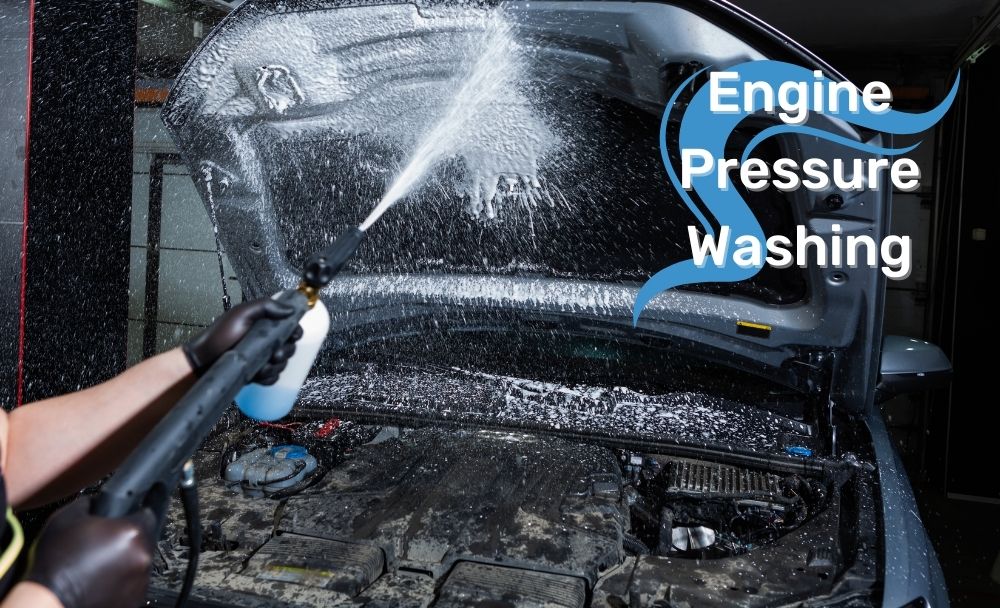
Pressure washing your engine is an integral part of maintaining its performance and keeping it running smoothly. You can clean your engine safely and efficiently with the right approach and knowledge.
But if you’re like me, you hardly look under the hood of your car, let alone clean it. So you might wonder, can you pressure wash an engine? You can, with care.
This step-by-step guide will cover everything you need to know about pressure washing your engine, including what you need to know before you start, how to pressure wash your engine safely, and some problems you may encounter – and know how to avoid.
Let’s get started:
What You Need Before Cleaning an Engine Bay:
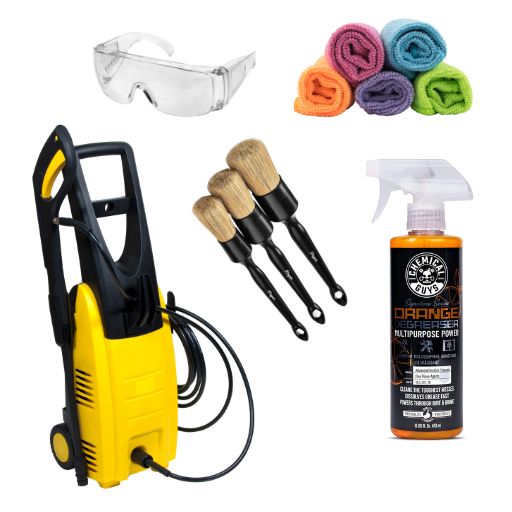
- A pressure washer (also known as a power washer) connected to your garden hose or water source
- An old soft cloth or microfiber towel (a few may be handy)
- Engine degreaser or car engine cleaning product (Chemical Guys is a popular choice – Amazon link)
- Plastic bags or plastic wrap to protect electrical components. Check under the hood for the IP rating on your electricals. Any IP rating of 5 or less should be covered to protect it from water splashes when cleaning your vehicle.
- A scrub brush for cleaning road grime and dirty areas
- Wear protective clothing, such as goggles and gloves, to protect yourself from the water and any debris that may be dislodged during the cleaning process.
What You Need to Know Before Pressure Washing Your Car’s Engine Bay
Cleaning your car engine is integral to your vehicle’s maintenance and should not be overlooked. There is a right and wrong way to clean your car engine. Here are some tips:
- Keep the nozzle approximately 12 inches away from the engine components
- Use a low setting and turn up the pressure gradually
- Cover electrical parts with plastic – including the fuse box, alternator, spark plugs, battery, distributor, and in newer cars, the electronics. You do not want water getting in here.
- Choose your cleaner wisely. Look for a non-corrosive cleaner designed for engine parts, a degreaser for any oil or grease buildup, or a car wash shampoo suitable for car engines.
It is essential to exercise caution when pressure washing an engine, as the high pressure of the water can potentially damage sensitive components if not used properly.
Make sure to use the lowest pressure setting that is effective for cleaning, and avoid directing the water jet directly at electrical components or other sensitive areas.
How to Pressure Wash Your Engine Safely
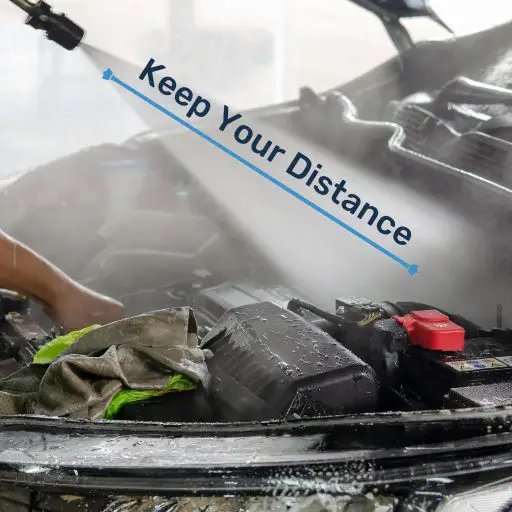
- Begin with a cold engine. If you have recently driven your car and the engine is hot, leave it parked in the driveway or garage for at least 30 minutes until it has cooled.
- Remove loose debris and dirt from the engine bay using a soft-bristled brush or a compressed air nozzle.
- Spray any oily, greasy or dirty areas with your chosen engine cleaner.
- Allow the degreaser to sit on the surface of the engine for at least a few minutes to penetrate and loosen any dirt, grime, or grease.
- If needed, use a soft-bristled brush or a rag to scrub the surface of the engine, paying particular attention to areas with heavy buildup.
- Set the pressure washer to a low setting and rinse the engine bay. Start at the back and work your way forward. Be sure to spray the corners and crevices, as grime accumulates in these areas.
- Finally, dry the engine and any other components with a cloth. Leave the hood of the car open to air dry if you can. Otherwise, compressed air can also help blow the water out of tiny crevices and hard-to-reach areas.
- Any vinyl or plastic under the hood can be sprayed with a nourishing product such as Carpro Pearl (Amazon affiliate link). Wipe off any excess and give it a slight buff. Not only will this protect your vehicle, but it will also give it a nice shine.
- Finally, remove any plastic bags or wrap used to cover engine components and prevent water from entering.
Possible Problems When Using a Pressure Washer to Wash a Car Engine
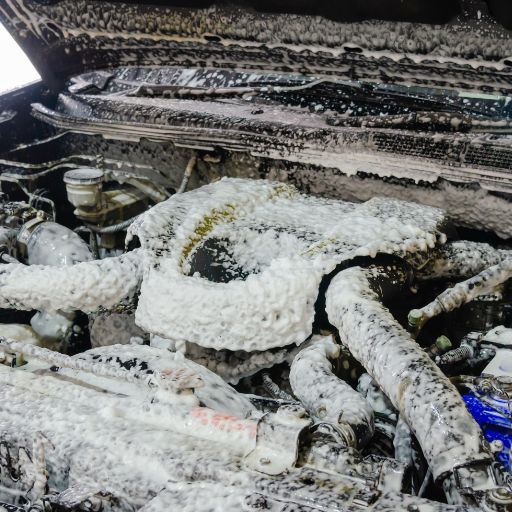
Using a pressure washer on a car engine can seem like a good idea, but there are a few potential problems you should be aware of.
The high-pressure water can force water into places it shouldn’t go, like gaps in the engine and even inside the engine itself. This can cause corrosion and damage to the electrical components and lead to a short circuit.
Additionally, the pressure of the water can dislodge or loosen parts, such as seals, gaskets, and hoses, leading to costly repairs or even a complete breakdown of the engine.
So before you pressure wash your car engine, it’s crucial to weigh the pros and cons.
In some cases, professional engine cleaning may be the best option. Too much water pressure can force water jets into air intake systems, causing hydro-lock and stalling.
For all these reasons, it’s essential to be careful when using pressure washers on engines. If you decide to go ahead, make sure you use a detergent with a low pH and an appropriate nozzle setting to minimize potential damage.
You can also use a soft-bristled brush, an automotive steam cleaner, and elbow grease. Using steam to wash a car engine will make the job easier without all the water from a pressure washer.
What Are the Benefits of Pressure Washing Your Car Engine?
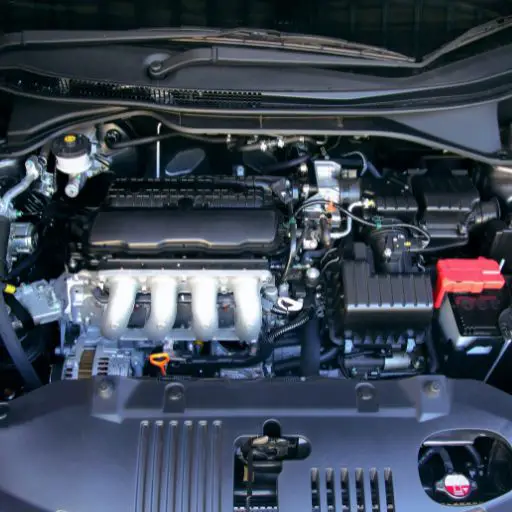
Here are a few benefits of utilizing a pressure washer on your engine:
- It helps to remove dirt and debris that can accumulate on the engine and cause it to run less efficiently.
- Increased lifespan: Keeping the engine clean can help extend its lifespan by preventing wear and tear on the various components.
- Easier maintenance: Cleaning the engine regularly can make it easier to spot any issues or problems that may need to be addressed.
- Enhanced appearance: A clean engine can make the car look more attractive and well-maintained.
- Improved safety: Removing dirt and debris from the engine can help reduce the risk of fires or other safety hazards.
Overall, pressure cleaning a car engine can be an effective way to maintain and improve the performance and appearance of the vehicle.
Conclusion
You can have a clean engine safely and efficiently with the right approach to pressure washing and a little knowledge.
I hope this step-by-step guide has covered everything you need to know. Don’t forget to read your car manuals in conjunction with this guide for specific advice for both older cars and newer ones.
- Can You Use a Steam Mop On Karndean Flooring? - June 19, 2024
- How To Clean Unsealed Concrete Floors - June 7, 2024
- How to Clean Stamped Concrete - June 7, 2024

